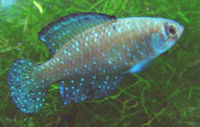Difference between revisions of "Austrolebias nigripinnis"
m |
(→Origin) |
||
| Line 38: | Line 38: | ||
== Origin == | == Origin == | ||
| − | + | The Blackfin Pearlfish originates from the diverse aquatic landscapes of South America, specifically being found in Uruguay and Brazil. This species is part of the larger family of killifishes, known for their adaptability to varying environmental conditions and their presence in temporary or seasonal bodies of water. The natural habitat of the Blackfin Pearlfish includes shallow pools, marshes, and slow-moving waters, where they have evolved to thrive in environments subject to seasonal fluctuations. These environments often experience changes in water levels, with the fish adapting to periods of drought by utilizing a unique reproductive strategy. | |
| + | |||
| + | In their native regions, the Blackfin Pearlfish encounters habitats with a mix of aquatic vegetation, submerged substrates, and areas suitable for egg deposition. The killifish's ability to lay eggs in the substrate and endure drying conditions is crucial for their survival, as it allows the species to persist through periods when their temporary habitats may dry up. Understanding the species' natural history and reproductive adaptations is essential for creating suitable conditions in captivity and contributing to the conservation of their wild populations. | ||
| − | |||
== Sexing == | == Sexing == | ||
:Males are brightly coloured, while the smaller females tend to be brownish-grey. | :Males are brightly coloured, while the smaller females tend to be brownish-grey. | ||
Revision as of 16:59, 20 November 2023
Blackfin Pearlfish
Austrolebias nigripinnis
45 Litres (12 US G.)
6-7 cm (2.4-2.8")
Freshwater
3 - 7
15.6-20°C (60 -68 °F)
1-10 °d
1:2 M:F
0.5-1 years
Family
Rivulidae
| You can contribute to the Aquarium Wiki by expanding this article. Dont be shy!. |
Contents
Additional names
- Blackfin Pearlfish, Blackfin Pearl Killifish, Dwarf Argentine Pearlfish
Additional scientific names
- Cynolebias nigripinnis, Cynolebias nigripinnis nigripinnis
Origin
The Blackfin Pearlfish originates from the diverse aquatic landscapes of South America, specifically being found in Uruguay and Brazil. This species is part of the larger family of killifishes, known for their adaptability to varying environmental conditions and their presence in temporary or seasonal bodies of water. The natural habitat of the Blackfin Pearlfish includes shallow pools, marshes, and slow-moving waters, where they have evolved to thrive in environments subject to seasonal fluctuations. These environments often experience changes in water levels, with the fish adapting to periods of drought by utilizing a unique reproductive strategy.
In their native regions, the Blackfin Pearlfish encounters habitats with a mix of aquatic vegetation, submerged substrates, and areas suitable for egg deposition. The killifish's ability to lay eggs in the substrate and endure drying conditions is crucial for their survival, as it allows the species to persist through periods when their temporary habitats may dry up. Understanding the species' natural history and reproductive adaptations is essential for creating suitable conditions in captivity and contributing to the conservation of their wild populations.
Sexing
- Males are brightly coloured, while the smaller females tend to be brownish-grey.
Breeding
- Set up a species tank, with a 2" layer of peat, and several hiding places for the female. The spawning embrace takes place, and the eggs are deposited in the peat. Remove the peat and eggs, squeeze most of the water out of the peat, put in a plastic bag and wait 2-4 months before placing the eggs back in fresh, soft water. If hatching doesn't occur put the eggs back and try again later.
Diet
Environment specifics
- Prefers slightly acidic, soft water at 15.6-20°C (60-68°F) . Skittish and hard to care for, it nevertheless has a matchless beauty when in top physical condition.
Pictures
External links
- Fishbase (Mirrors:
 )
)
